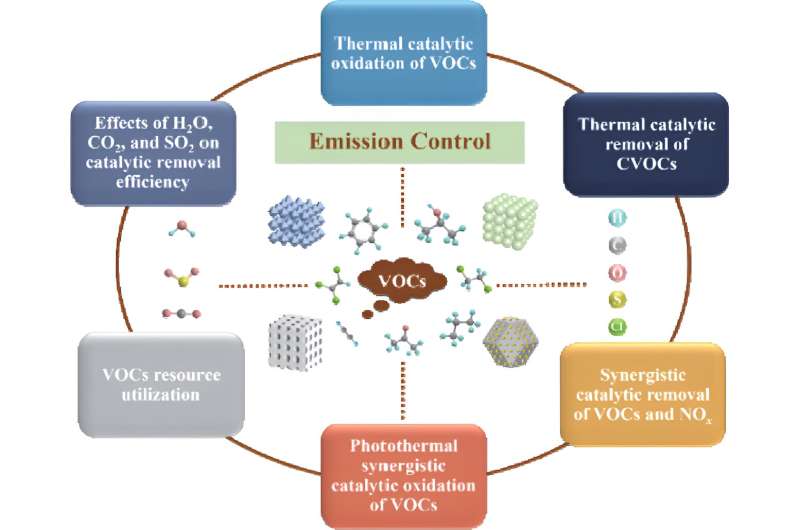This article has been reviewed according to Science X's editorial process and policies. Editors have highlighted the following attributes while ensuring the content's credibility:
fact-checked
trusted source
proofread
Examining progress on volatile organic compound pollution control via the catalytic method

Volatile organic compounds (VOCs), with toxicity and irritability, could cause atmospheric environmental problems such as haze and photochemical smog, seriously threatening the ecological environment and human health. The primary source of VOCs is human production, such as the petrochemical, pharmaceutical and footwear industries, electronic manufacturing, and cooking fumes.
Catalytic oxidation technology can effectively remove organic pollutants without secondary pollution, and it is receiving increasing attention in VOC pollution control. In real-world operating conditions, the coexistence of VOCs (alkanes, aromatic hydrocarbons, halogenated hydrocarbons, aldehydes, ketones, alcohol esters) and impurity gas molecules (H2O, CO2, and SO2) makes it difficult for the catalyst to remove multi-component pollutants effectively and prevent poisoning.
A research team led by Prof. Hongxing Dai and Prof. Jiguang Deng from Beijing University of Technology, China, reports the research progress of VOC elimination via thermal catalysis or photothermal catalysis over the past 10 years, including eliminating single-component VOC or multi-component VOCs, synergetically purifying VOCs and NOx, and realizing VOC resource utilization.
The research is published in the Chinese Journal of Catalysis.
The catalytic degradation of VOCs is achieved by adopting single or composite metal oxide catalysts, porous metal oxide catalysts, supported noble metal nanocatalysts, and single-atom catalysts.
A detailed summary of the pathways and mechanisms of VOC catalytic conversion has also been provided. The catalytic activity and stability of catalysts affect their lifespan and cost of use. For supported noble metal catalysts, which usually have poor stability, some unique design strategies have been outlined, such as alloying strategy, reducing atmosphere treatment, or embedding noble metals into the support.
The effect mechanisms of H2O, CO2, and SO2 on the catalysts in the specific VOC reaction process are sketched and assist in designing anti-poisoning catalysts.
Finally, future research directions are prospected. For example, catalytic conversion of VOCs and CO2, as well as catalytic purification of VOCs and NOx, aid in the reduction of pollution and carbon emissions; thorough investigation into the mechanism of coupling external fields (light, electrical, or magnetic energy) for the thermal catalytic destruction of VOCs; developing and synthesizing innovative catalysts to accomplish broad-spectrum control of VOC pollution, as well as a deeper knowledge of the catalytic VOCs oxidation process through the combination of theoretical calculations and in situ characterization approaches.
More information: Honghong Zhang et al, Recent progress on VOC pollution control via the catalytic method, Chinese Journal of Catalysis (2024). DOI: 10.1016/S1872-2067(24)60043-4
Provided by Chinese Academy of Sciences





















